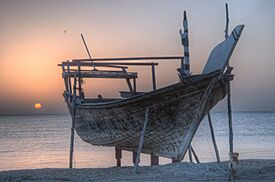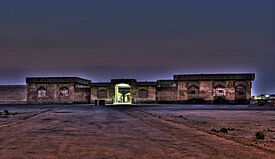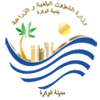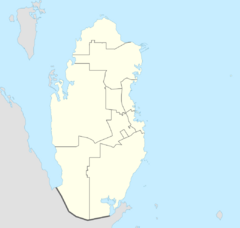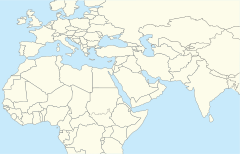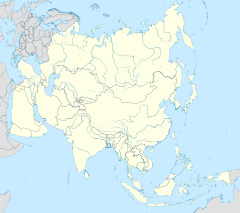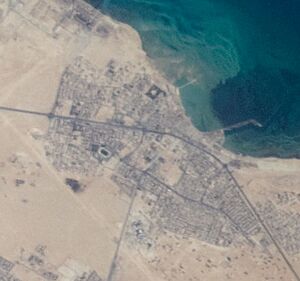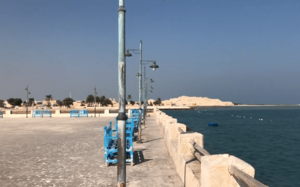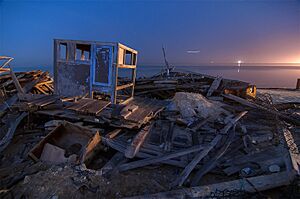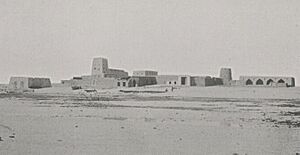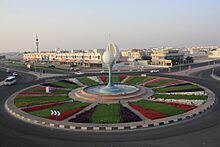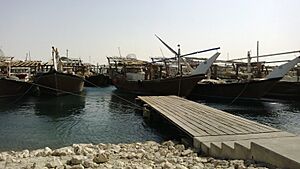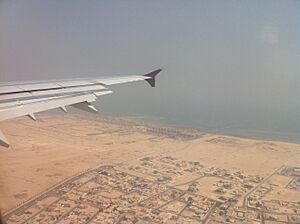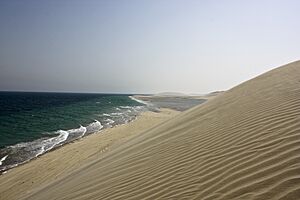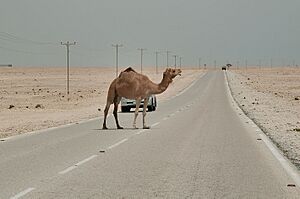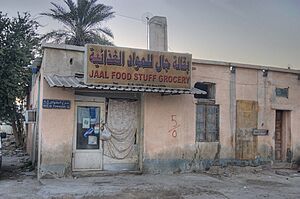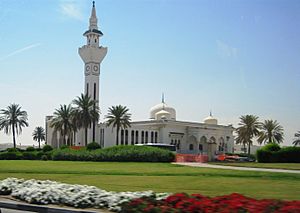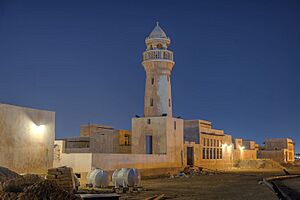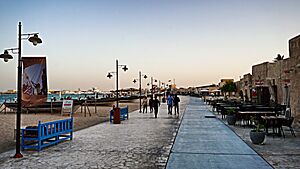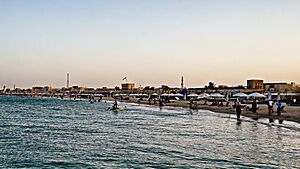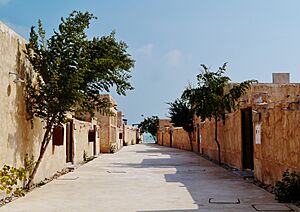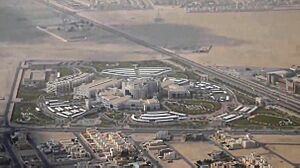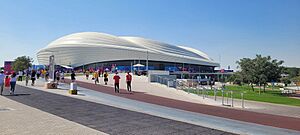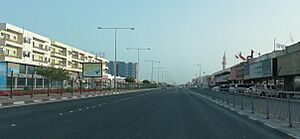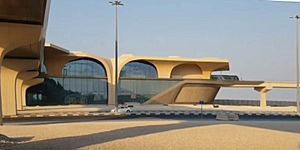Al Wakrah facts for kids
Quick facts for kids
Al Wakrah
الوكرة
|
||
|---|---|---|
|
Top to Bottom, Left to Right: A lone fishing vessel on the coastline, Workers traveling along Al Wakrah Corniche in the Al Wakrah Heritage Village, Traditional stone buildings in Al Wakrah Heritage Village, Renovated fort of Sheikh Abdulrahman bin Jassim Al Thani (now known as Al Wakrah Fort)
|
||
|
||
| Country | ||
| Municipality | Al Wakrah Municipality | |
| Area | ||
| • Total | 75.8 km2 (29.3 sq mi) | |
| Population
(2015)
|
||
| • Total | 87,970 | |
| • Density | 1,160.6/km2 (3,005.8/sq mi) | |
| Time zone | UTC+03 | |
| ISO 3166 code | QA-WA | |
Al Wakrah (Arabic: الوكرة, romanized: al-Wakra) is a major city in Qatar. It is the capital of the Al Wakrah Municipality. The city is located on the eastern coast of Qatar, right by the Persian Gulf. Qatar's capital city, Doha, is just north of Al Wakrah.
Long ago, Al Wakrah was a small village known for fishing and pearling. It was ruled by Sheikh Abdulrahman bin Jassim Al Thani. Over time, it grew into a city with more than 80,000 people. Today, it is one of Qatar's biggest cities.
In the past, Al Wakrah was a busy center for pearl diving. By 1920, about 300 ships were in its harbor. Later, in 1925, a study showed 250 boats. When Qatar started finding a lot of oil in the mid-1900s, Al Wakrah became important. This was because it was close to the Mesaieed Industrial Area, which is Qatar's main industrial hub and oil port.
Since the early 2000s, Al Wakrah has grown a lot. The city of Doha has also expanded and is getting closer to Al Wakrah. Some big changes in recent years include the opening of Al Janoub Stadium in 2019. This stadium was used for the 2022 FIFA World Cup. The Souq Al Wakrah opened in 2014, and the city's main road was improved. Al Wakrah also became part of the Doha Metro's Red Line in 2019.
Contents
What's in a Name?
The name "Al Wakrah" comes from the Arabic word "wakar". This word means "bird's nest". The city got its name from a nearby hill, likely Jebel Al Wakrah. Many birds used to build their nests there.
A Look Back in Time
How Al Wakrah Started
A British official named Arnold Burrowes Kemball wrote about Al Wakrah in 1845. He said that in 1822, Al Wakrah didn't exist. He believed the city was started by Ali bin Nasir, a leader of the Ajman tribe. Ali bin Nasir used to live in Al Bidda (which is now Doha).
After a disagreement with the ruler of Bahrain, Ali bin Nasir and his people had their homes destroyed. They were also threatened with being forced to move to Bahrain. To avoid this, they built a new settlement at the foot of Jebel Al Wakrah. Some old buildings suggest that Al Wakrah might have been Qatar's first major town.
Under Al Khalifa Rule
In 1851, a battle happened near Al Wakrah called the Battle of Mesaimeer. It was between Qatari forces and an army from the Emirate of Nejd. The Qatari leader, Mohammed bin Thani, made a peace deal with the invading army.
Later, in 1863, the ruler of Bahrain sent his cousin to govern Qatar. But the people of Qatar soon made him leave. This happened after he arrested the ruler of Al Wakrah and other important people, sending them to Bahrain.
In 1866, another event called the Al Wakrah Incident took place. A Qatari man was arrested in Al Wakrah market and sent to Bahrain. This caused more tension.
The Qatari–Bahraini War
In 1867, the ruler of Bahrain tricked a Qatari leader, Jassim bin Mohammed Al Thani, into coming to Bahrain and then imprisoned him. After this, Bahrain and Abu Dhabi attacked Qatar. They raided and destroyed Al Wakrah and Doha. A British record said that "the towns of Doha and Wakrah were... temporarily blotted out of existence".
In 1868, Qatari forces tried to fight back. They were defeated in one battle but then fought bravely in the Battle of Jebel Wakrah near Al Wakrah. They surrounded the Bahraini forces and captured two of their commanders. After this, prisoners were exchanged.
Because of this war, a British official named Lewis Pelly stepped in. He removed the ruler of Bahrain from power. Pelly then went to Al Wakrah and met with Mohammed bin Thani. They signed an important agreement where the British recognized the Al Thani family as the rulers of Qatar.
Under Ottoman Rule (1871–1916)
The 1800s
After Qatar came under Ottoman control, a report in 1872 said that Al Wakrah had only about 400 people. This was because of the war. It also had about 50 ships.
In 1885, about 100 people from Al Wakrah left the town. They moved to Al Ghariyah because of a disagreement with Sheikh Jassim bin Mohammed Al Thani. This led to some fighting, but eventually, the conflict ended.
In 1887, during a war between Qatar and Abu Dhabi, Sheikh Zayed of Abu Dhabi complained to British officials. He said that a ship from Al Wakrah had attacked other boats. He blamed Jassim bin Mohammed and Ali bin Rashid of Al Wakrah for this.
A British survey in 1890 said that Al Wakrah had been rebuilt after the 1867 war. It had 12 forts and at least 1,000 people. They also noted Jebel Al Wakrah, a rocky hill 85 feet high, located a mile south of the town.
The 1900s
In 1900, a small conflict happened off the coast of Al Wakrah between two tribes. A relative of Jassim bin Mohammed Al Thani helped calm the situation.
In 1902, the Ottomans tried to take more control by placing officials in Al Wakrah. However, the British were not happy about this. By 1904, the Ottomans removed these positions. Sheikh Abdulrahman bin Jassim Al Thani was briefly appointed as an official by the Ottomans in 1903.
From 1907, there were arguments between the governor, Sheikh Abdulrahman, and the Al-Buainain tribe. The tribe didn't want to pay a boat tax. This led to more tension between the British and the Ottomans.
A British diplomat, J.G. Lorimer, described Al Wakrah in 1908. He said the town had 250 houses and about 1,000 people. It was about 10 miles from Al Bidda, another pearling village. He described Al Wakrah as "thriving and more cheerful" than Al Bidda.
Under British Protection (1916–1971)
A British survey in 1925 gave many details about Al Wakrah. Most houses were made of mud and stone. A new part of town called Rumailah had grown about 800 yards north. The city had 8,000 people. Most people in Al Wakrah were pearl divers, sailors, and fishermen. The report also said Al Wakrah had 75 shops.
After Independence
After Qatar became independent in 1971, Sheikh Khalifa bin Hamad Al Thani became the ruler. He wanted to build more outside of Doha. In 1972, he ordered a new jetty (a landing place for boats) to be built in Al Wakrah.
The city's first park, Al Wakrah Public Park, was finished in the mid-1980s. During this time, the city council also started cleaning beaches, building new roundabouts, and naming streets. In 1986, a deal was signed to build a secondary school for boys in Al Wakrah.
In 2008, a plan was made to develop Al Wakrah. This plan included improving Al Wakra Beach and the city center. The goal was to make the city ready for more than 600,000 people.
Al Janoub Stadium, a football stadium with a roof that can open, was opened on May 16, 2019. It was the second stadium built for the 2022 FIFA World Cup in Qatar. The famous architect Zaha Hadid designed it.
In 2017, Al Wakrah became the first Qatari city to join the UNESCO Global Network of Learning Cities. This means it offers many learning chances to its people. In 2021, Al Wakrah won the UNESCO Learning City Award. It was recognized for helping workers, having recycling programs, and giving free computers for education.
Where is Al Wakrah?
Al Wakrah is on the Persian Gulf to its east. It is about 15 kilometers (9 miles) south of Doha. It is also about 72 kilometers (45 miles) south of Al Khor and 21 kilometers (13 miles) north of Mesaieed.
In 2010, a survey of Al Wakrah's coastal waters was done. It found that the water was shallow, about 2.25 meters (7.4 feet) deep on average. The water was also quite salty and warm.
Al Wakra's coastline has special rock formations from a very long time ago. These include ridges made of cemented sandstone and limestone. These formations look like small cliffs or low ridges that run along the shoreline. They were formed when ocean levels were higher than they are today.
Near Jebel Al Wakrah, you can see old coastal sand dunes. These are now low hills made of hardened sand. They formed during a time when sea levels were lower.
The Al Wakrah Spit
The Al Wakrah Spit is a narrow sandy strip of land. It stretches about 2.5 kilometers (1.6 miles) into the Persian Gulf. It used to be connected to the mainland. But by 1973, it had separated from the shore. Now, it has two openings that divide it into sandy ridges. The strong north-westerly wind, called the shamal, helps shape this spit.
West of the spit is a lagoon (a shallow body of water). This water is protected and has tides that go up and down by about 0.5 to 1 meter (1.6 to 3.3 feet). The area offshore has sand banks. These are formed by currents that move sand along the coast.
The sand on the spit is a mix of white sand, shell pieces, and bits from coral reefs. Sometimes, during storms, waves wash sand onto the muddy lagoon area.
Animals and Plants
Common plants found in Al Wakrah include horbith, jrnah, woolly-winged milkwort, evening stock, kebaisha, and lomi albar. Near Jebel Al Wakrah, you can also find rigid flax and barseem.
In the 1980s, mangrove trees (specifically Avicennia marina) were planted along Al Wakrah's coast. This was done to stop erosion and protect habitats. These trees have grown into large forests. As of 2015, about 112 hectares (277 acres) of mangroves are off Al Wakrah's coast.
In the southern part of Al Wakrah, honey badgers have been seen. They are locally called al zerembal.
Weather in Al Wakrah
Like other cities in Qatar, Al Wakrah has mild temperatures in winter (January, February, March, November, December). The summer season is from April to October. Al Wakrah usually has dry weather from January to August. July is the warmest month, and January is the coolest.
| Climate data for Al Wakrah | |||||||||||||
|---|---|---|---|---|---|---|---|---|---|---|---|---|---|
| Month | Jan | Feb | Mar | Apr | May | Jun | Jul | Aug | Sep | Oct | Nov | Dec | Year |
| Mean daily maximum °C (°F) | 22 (72) |
23 (73) |
27 (81) |
32 (90) |
38 (100) |
41 (106) |
42 (108) |
41 (106) |
39 (102) |
35 (95) |
30 (86) |
24 (75) |
33 (91) |
| Mean daily minimum °C (°F) | 13 (55) |
14 (57) |
17 (63) |
21 (70) |
25 (77) |
28 (82) |
29 (84) |
29 (84) |
27 (81) |
23 (73) |
20 (68) |
15 (59) |
22 (71) |
| Average precipitation mm (inches) | 12.7 (0.50) |
17.8 (0.70) |
15.2 (0.60) |
7.6 (0.30) |
2.5 (0.10) |
0 (0) |
0 (0) |
0 (0) |
0 (0) |
0 (0) |
2.5 (0.10) |
12.7 (0.50) |
71 (2.8) |
| Source: weather.com | |||||||||||||
Old Buildings and History
Al Wakrah has many old buildings, especially near the coast. These include mosques, old homes, and the harbor. A famous landmark is the Al Wakrah Fort, built in the early 1900s. It stands on the remains of an older fort that belonged to Sheikh Abdulrahman bin Jassim Al Thani. The fort has two round towers and used to be a police office.
Inside the fort, people found old date presses, called madabis. These were used to make food for soldiers during times of trouble. Al Wakrah also has more historic wind towers than any other place in Qatar.
Historic Homes
The house of Sheikh Ghanim Bin Abdulrahman Al-Thani is an important old building located on the beach. It has two floors and windows with special designs. It was fixed up in 2004. Old date presses were also found here.
The Abdullah bin Saad House is another historic landmark. It was built around 1920. The city took ownership of the house in 1984, fixed it up, and opened it as a museum.
Old Mosques
Al Ayouni Mosque, built around 1935, was once the biggest mosque in Al Wakrah. It was near the coast because that was the busiest part of the city. It has a square shape and only one entrance on the east side, which is unusual for mosques from that time.
Abu Manaratain Mosque, a smaller mosque, was built in 1940 near the shore. Its name suggests it might have had two minarets (towers for calling prayers) in the past. It has five entrances.
The Al Subaiei Mosque, built around 1940, is near the Al Wakrah Museum. It has been used continuously and has been updated over the years. Its minaret has a square base.
New Projects and Growth
Al Wakrah Development Project
In 2008, city officials shared a big plan for Al Wakrah's future. The plan aimed to show off the city's history of pearl diving. It included building a public waterfront, a water park, a golf course, a maritime museum, hotels, and a cultural center.
This project, called the Al Wakrah Development Project, also had a "New Downtown" area with seven parts:
- The Wakrah Gateway: For government offices and public services.
- South Square: For offices, homes, and shops.
- The Festival Bay: For hotels, a maritime museum, and an arts center.
- Wakrah Sands: For family fun, like parks and entertainment.
- Wakrah Residence: Mainly for homes.
- Wakrah College: For schools and colleges.
- Wakrah Trade Center: For malls and shopping.
This project was part of Qatar's larger plan for urban development. The goal was for Al Wakrah's population to reach 600,000 by 2030. It's not clear if all parts of this big project are still happening.
Al Wakrah Main Road Project
In late 2018, the Public Works Authority (Ashghal) started a big project to improve Al Wakrah's roads. This project cost QR 600 million (about $165 million USD). It involved making 9 kilometers (5.6 miles) of the main road wider, from two lanes to three. They also added four new intersections and changed roundabouts into controlled intersections.
A tunnel was built near the Al Wakrah Metro Station. New paths for walking and cycling were also added. The project was planned in three stages and was expected to finish by 2020, but the date was later changed to late 2024.
Fun Places to Visit
Al Wakrah has many public parks and fun places planned. One of the most important is Al Wakrah Heritage Village. This village includes Souq Al Wakrah, Al Wakrah Corniche, and a mosque. It stretches over 3 kilometers (1.9 miles) along the waterfront near Al Wakrah Port.
The village was first thought of in 2008 and officially opened in December 2014. The souq has over a hundred shops selling traditional crafts and many restaurants.
The Wakrah Mall, a large multi-story mall, opened in December 2016. It has over 40,000 square feet of shops.
Beaches for Everyone
The city has two main public beaches: Souq Al Wakrah Beach and Al Wakrah Family Beach. They are only a few minutes apart. Souq Al Wakrah Beach opened in mid-2017. It's a family-friendly beach where you can also do some water sports. It has a large playground area, which opened in 2018. The playground has equipment for kids and fields for football and volleyball.
Al Wakrah Family Beach is very popular. The beach is flat, and the water is very shallow. It has playgrounds for children, barbecue areas, parking, changing rooms, and gazebos. You can also play football and volleyball there.
Souq Al Wakrah
Souq Al Wakrah opened in late 2014. It is right on Al Wakrah Beach. The souq has traditional buildings and old-fashioned houses, along with shops.
There are many restaurants along the coastline in the market complex. You can also see replica dhows (traditional boats) on the shore. Next to the market is the Souq Al Wakrah Hotel, which opened in 2018.
Al Wakrah Public Park
Al Wakrah Public Park was the city's first park, built in the mid-1980s. It covers an area of 47,000 square meters (about 11.6 acres). You can enter it through the Pearl Monument. The park has paths for cycling and walking. Hundreds of native trees have been planted throughout the park.
Health Services
Al Wakrah Hospital opened in December 2012. It is a general hospital with 325 beds and 217 doctors. It covers a large area of over 300,000 square meters (about 74 acres). The hospital offers modern medical and surgical care to the southern part of Qatar, including Al Wakrah and Mesaieed. It has wards for surgery, childbirth, women's health, dentistry, skin care, and children. A special center for diabetes was opened in December 2014.
Learning and Schools
Al Wakrah Public Library, the city's first library, opened in 1985. It was the sixth library in Qatar. At that time, it had 15,000 Arabic books and 2,000 foreign books. There was also a special area for children.
The Dar Abdulrahman Darwish Fakhroo Quran Learning Center for Women is located in the city center.
Here are some schools in Al Wakrah:
| Name of School | Curriculum | Genders | Official Website | Ref |
|---|---|---|---|---|
| Abdulrahman Bin Jassim Preparatory Boys School | Independent | Boys-only | N/A | |
| Al Bustan Private Kindergarten | American | Both | N/A | |
| Al Salam Independent Kindergarten | Independent | Both | N/A | |
| Al Salam Elementary Independent Girls School | Independent | Girls-only | N/A | |
| Al Sanafer Nursery | N/A | Both | N/A | |
| Al Shrouq Model School | Independent | Boys-only | N/A | |
| Al Wakrah Independent Secondary School For Boys | Independent | Boys-only | N/A | |
| Al Wakrah Independent Secondary School For Girls | Independent | Girls-only | N/A | |
| Al Zohour Nursery | British | Both | N/A | |
| Babies Club Nursery | British | Both | N/A | |
| Bait Ommy Nursery | N/A | Both | N/A | |
| Bhavan's Public School | Indian | Both | Home page | |
| Blue Bells Nursery | British | Both | N/A | |
| Dew Drops Nursery | British | Both | N/A | |
| Doha British School Al Wakra | British | Both | Home page | |
| English Modern School Al Wakra | British | Both | Home page | |
| GEMS American Academy | American | Both | Home page | |
| Green Apple Nursery | British | Both | N/A | |
| Kangaroo Kids Preschool | N/A | Both | Home page | |
| Little Flower Kindergarten | Indian | Both | Home page | |
| Our Little Treasures | N/A | Both | N/A | |
| Qatar Academy Al Wakra | Mixed | Both | Home page | |
| Saoud Bin Abdulrahman Kindergarten for Boys | Independent | Boys-only | N/A | |
| Saoud Bin Abdulrahman Model School | Independent | Boys-only | N/A | |
| Shantiniketan Indian School | Indian | Both | Home page | |
| DPS Modern Indian School | Indian | Both | Home Page | |
| Vision International School | American | Both | Home Page |
Sports in Al Wakrah
Al Wakrah has a sports club called the Al-Wakrah Sports Club. Its football team plays in Qatar's top league, the Qatar Stars League. The club's home stadium is the Saoud bin Abdulrahman Stadium, which can hold 20,000 people.
The city also helped host the 2022 FIFA World Cup at Al Janoub Stadium. This stadium can hold 40,000 fans. It also has a marketplace, a school, restaurants, and parkland nearby. The design of the stadium, created by Zaha Hadid, looks like the sails of a traditional boat called a dhow. After the World Cup, Al Wakrah Sports Club took over this stadium.
Getting Around
The Karwa Transportation Company (Mowasalat) connects Al Wakrah to other cities in Qatar with bus routes.
Al Wakrah has almost 3,000 streets. To travel between Al Wakrah and Doha, people mainly use two highways. These are the 22-kilometer (14-mile) G Ring Road and the southern part of the Doha Expressway.
Other important roads in Al Wakrah include Al Wakrah Road and Al Wukair Road. Al Wakrah Road is a wide street with four lanes of traffic.
The city's transportation system is being improved as part of the Al Wakrah Main Road Project. This project started in late 2018 and is expected to finish in late 2024.
Metro Station
The Al Wakra station is part of the Red Line of the Doha Metro. It opened on May 8, 2019, along with other Red Line stations. It is located on Al Wakrah Road.
The station has ATMs, a prayer room, restrooms, and a parking lot. There are also five "metrolinks" (feeder buses) that serve the station:
- M127, which goes to Souq Al Wakra.
- M128, which goes to Al Wakrah South.
- M130, which goes to Ezdan Village 4-7 (Al Wukair).
- M131, which goes to Ezdan Village 3 and 8–11 (Al Wukair).
- M134, which goes to Al Wakrah South and Al Wakrah Hospital.
City Leadership
When Qatar first held elections for the Central Municipal Council in 1999, Al Wakrah was the main area for constituency no. 10. It stayed this way for the next three elections. In the 2015 elections, it became the main area for constituency no. 20. This area also includes Mesaieed, Al Wukair, and other nearby places.
In the first election in 1999, Ahmed Jassim Al-Muftah won. Hassan Abbas Abdul Rahim was elected in 2002 and won again in 2007 and 2011. For the 2015 elections, Mansour Ahmad Yousif Al-Khater was elected.
How Many People Live Here?
| Historical population | ||
|---|---|---|
| Year | Pop. | ±% |
| 1986 | 17,245 | — |
| 1997 | 24,283 | +40.8% |
| 2004 | 31,441 | +29.5% |
| 2010 | 79,457 | +152.7% |
| 2015 | 87,970 | +10.7% |
| c-census; e-estimate | ||
In 2010, the city had 8,436 homes and 796 businesses. There were 79,457 people living in Al Wakrah. About 75% were male and 25% were female. Most people (81%) were 20 years old or older. The literacy rate (how many people can read and write) was very high, at 98.4%.
About 73% of the people living in Al Wakrah had jobs. Most of the working population (88%) were male, and 12% were female.
Global Connections
Sister Cities
Al Wakrah is connected with other cities around the world. These are called "twin towns" or "sister cities":
 Ramsar, Iran (since 2010)
Ramsar, Iran (since 2010) Djougou, Benin (since 2014)
Djougou, Benin (since 2014)
See also
 In Spanish: Al Wakrah (ciudad) para niños
In Spanish: Al Wakrah (ciudad) para niños


